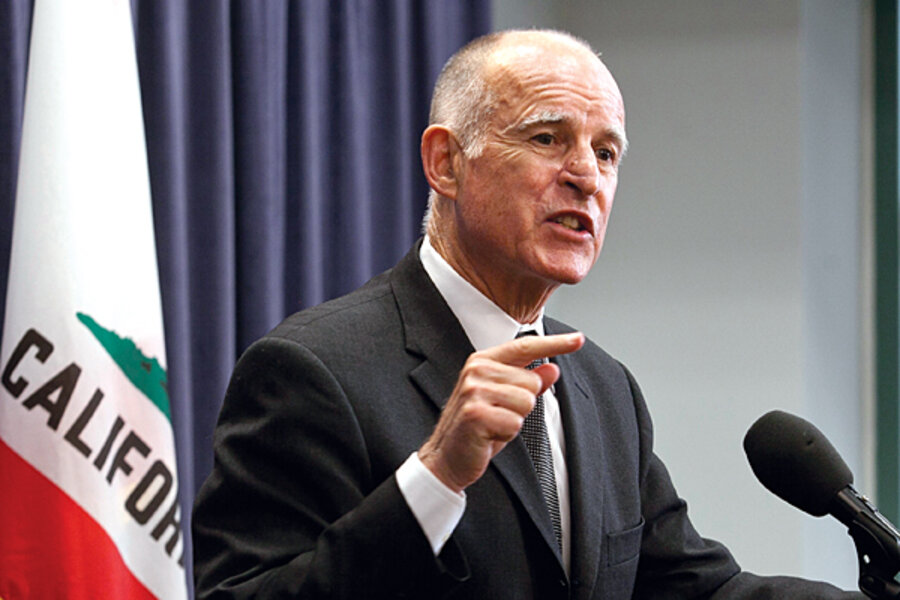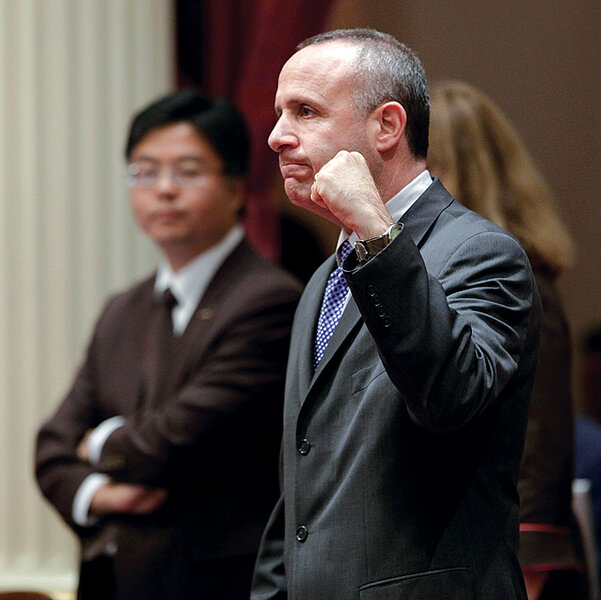California budget: A sign that the Golden State is finally on the right track?
Loading...
| Los Angeles
Is California becoming (gasp!) governable again?
With a new annual budget signed June 30 – on schedule for the first time in recent memory – California appears to have taken a step out of dysfunction and toward a profound remodeling of its politics.
Whatever kudos are due probably go to Golden State voters themselves. Last year they approved a suite of reforms intended essentially to reboot the state's political structure – after a decade marked by the recall of a governor, legislative gridlock, huge budget deficits papered over with dubious fixes, state-issued IOUs in lieu of payment, and a trashed credit rating.
Some critics say the reforms do not go far enough, suggesting that the ballot-initiative process that voters here wield with such enormous – and sometimes contradictory – effect must be brought under control. To others, though, this is the most fertile period of state reform in nearly a half century.
"California is in an era of reform, and I think 10 years from now, we will look back at these past two to three years as just the start of a broad movement to shake up the system and do things fundamentally different from the previous 50 years," says Mark Baldassare, president of the Public Policy Institute of California (PPIC).
Changes voters made
The reforms have altered some of the most important levers of government.
•Voters made clear in November that they were fed up with the partisan stalemates that have prevented a state budget from being delivered on time each year since 1986. They approved Proposition 25, which eliminated the provision that a budget must get two-thirds of the votes in the legislature to pass. Budgets now need only a majority vote. This change meant that majority Democrats were able to push through a budget in the closing days of June, before the start of the new fiscal year on July 1.
•Also in November, voters approved Proposition 20, which took redistricting for congressional seats out of legislators' hands. It followed the passage of Proposition 11 in 2008, which did the same for state legislative seats, creating a bipartisan commission to do the job instead. The hope is that this will lead to the election of a greater number of centrists and moderates.
•Last June, California voters passed Proposition 14, which eliminates partisan primaries for all statewide offices, state legislative seats, and congressional seats. Under Prop. 14, the top two vote-getters in a primary – regardless of political party – will advance to the general election. It takes effect this year.
Now, momentum is growing to amend California's term-limits law, one of the most restrictive in the nation, amid rising concern that state legislators are forced out just as they are starting to understand the big issues and how to do their jobs.
Along with electing budget fix-it man Jerry Brown (D) governor in November, California voters acknowledged in the flurry of ballot initiatives that the political process was broken and needed radical overhaul.
"Voters of this state have recognized that the state has serious fiscal, economic, and other structural problems and are working down a long list of ways to solve them," says Mr. Baldassare.
Exhibit A for shaking up the old political order is the just-ended annual battle over the budget – and both political parties felt the effect.
Though Republican lawmakers managed to block additional tax revenues, Prop. 25 allowed majority Democrats to enact a budget without GOP input on where to whittle billions of dollars to erase a deficit, which they did on June 28.
As for Democrats, Governor Brown vetoed their first budget blueprint on June 15, saying it was full of accounting gimmicks. That meant another provision of Prop. 25 kicked in, and lawmakers had to forfeit their pay until they approved a balanced budget. In the end, that amounted to about $5,000 each.
Redistricting revised
Another event may offer even stronger evidence of the political changes afoot here. On June 10, the redistricting commission created in 2008 released its new maps.
Redistricting maps drawn by legislators in previous years had resulted in gerrymandered districts crafted primarily to keep incumbents safe. The result was that blue districts became bluer and red districts got redder – and legislators became more partisan in their attempts to appeal to their polarized political bases. The room for compromise and political middle ground became paper thin.
Now, the citizen commission has drawn tentative lines, and the state has two months to comment and tweak the new maps. In general, political analysts applaud the commission for making the districts more moderate.
"They made both parties mad, which means they did a good job," says Barbara O'Connor, director emeritus of the Institute for Study of Politics and Media at California State University, Sacramento.
In one instance, one district of low-income Latino neighborhoods east of downtown Los Angeles has been combined with portions of wealthy Beverly Hills, upsetting some leading African-American and Latino organizations.
"We just don't think the issues and concerns of these two different communities can be adequately addressed by the same leaders," says Rosalind Gold of the National Association of Latino Elected Officials.
But some critics are being won over by the commission's work. A skeptical crowd at one gathering in San Francisco between the commission and local citizen groups was turned around by closer examination of the facts, says Zabrae Valentine, deputy director of California Forward, a nonpartisan public interest reform group.
"When the conversation started, the citizen attendees were very cynical and negative, but by the end they were all smiles, totally confident that the process was going to make a difference," says Ms. Valentine.
The 'Top 2' primary
California's new "Top 2" primary is seen almost as a companion to redistricting, moderating candidates in a different way. Instead of candidates appealing to the poles of their parties to win a partisan nomination, they will have to consider moving to the center, where the bulk of the electorate is.
"The idea of the Top 2 primary is that it will encourage candidates to look beyond their parties' base voters and seek to build a broad coalition right from the start," says Jack Pitney, professor of government at Claremont McKenna College in Claremont, Calif. "And to do so, the theory goes, candidates must be more flexible and pragmatic."
Voters' reform binge might not be finished. An initiative to amend California's term-limits rule will appear on the next state ballot.
"Now that people have had a chance to really examine what term limits have done to this state, they see two problems," says Valentine of California Forward. "One is that legislators are not there long enough to understand the complexity of such issues as the budget, or water, or education, or health care.
"The other thing," she adds, "is that they create a revolving door of people coming in, and before they have a chance to establish expertise or seniority they are already looking to their next election or trying to appeal to their next constituency."
The new initiative would apply a blanket 12-year limit on anyone in the Assembly, Senate, or both.
Current rules adopted by voters in 1990 limit members of the Assembly to six years and members of the state Senate to eight years.
The proposed reform had 68 percent approval among likely voters, according to a March PPIC poll. Yet, to some, that voter authority itself is the root of California's problem. Unless the state tackles reform of the citizen-initiative process, big problems will linger, says Jessica Levinson, political reform director for the Center for Governmental Studies.
"A lot of these are just incremental changes in the right direction, but not the fundamental, complete overhaul many wanted," she says, noting that the idea for a constitutional convention to overhaul the state constitution failed last year. "We have the most generous ballot initiative [process] in the country, and it has gotten us into trouble because a lot of stuff passes without due deliberation."






